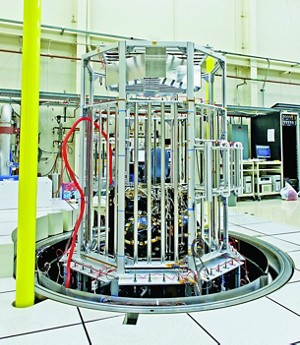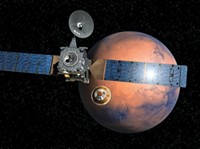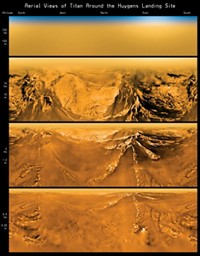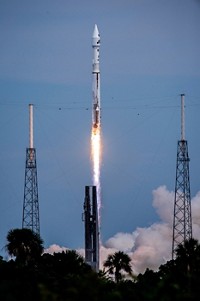Advertisement
Grab your lab coat. Let's get started
Welcome!
Welcome!
Create an account below to get 6 C&EN articles per month, receive newsletters and more - all free.
It seems this is your first time logging in online. Please enter the following information to continue.
As an ACS member you automatically get access to this site. All we need is few more details to create your reading experience.
Not you? Sign in with a different account.
Not you? Sign in with a different account.
ERROR 1
ERROR 1
ERROR 2
ERROR 2
ERROR 2
ERROR 2
ERROR 2
Password and Confirm password must match.
If you have an ACS member number, please enter it here so we can link this account to your membership. (optional)
ERROR 2
ACS values your privacy. By submitting your information, you are gaining access to C&EN and subscribing to our weekly newsletter. We use the information you provide to make your reading experience better, and we will never sell your data to third party members.
Physical Chemistry
LADEE Aims To Unlock Moon’s Glow
Upcoming NASA mission will answer decades-old question about light at the lunar horizon seen by Apollo astronauts
by Elizabeth K. Wilson
November 12, 2012
| A version of this story appeared in
Volume 90, Issue 46

The intense study of Earth’s natural satellite continues, as the National Aeronautics & Space Administration readies its latest lunar spacecraft for an orbiting mission to examine the moon’s atmosphere and dust.
NASA’s (Lunar Atmosphere & Dust Environment Explorer), which is set for launch in 2013, is part of the agency’s ongoing effort to determine whether the moon could serve as an outpost for human space missions. It will also answer a question that has mystified scientists since the Apollo missions: What is the source of a bright glow just above the moon’s horizon seen when the sun is behind the moon?
Because the moon’s atmosphere is too thin to cause such a glow, scientists speculate that lunar dust pulled up by electrostatic forces could be the source. The mission’s timing is also crucial, team members say, coming before further human exploration taints the pristine lunar environment.
“A mission like LADEE has been needed since Apollo, which left us with tantalizing hints about the dust and an exotic, tenuous atmosphere,” says Rick Elphic, LADEE project scientist.
Equipped with an ultraviolet and visible spectrometer, a mass spectrometer, and an instrument to collect lunar dust particles hovering in the atmosphere, LADEE will spend 100 days orbiting the moon. The mission is managed by NASA’s Ames Research Center in Moffett Field, Calif.
On Oct. 25, NASA announced it had completed installation of all of LADEE’s science instruments. “Now that the three science instruments are fully integrated onto the spacecraft, it has become a full-fledged, high-precision space observatory,” says Butler Hine, LADEE project manager.
The spacecraft is part of a robotic lunar armada with the ultimate objective to characterize the moon’s ability to serve as an outpost for human exploration. This goal has been promoted by the federal government for the past decade—spanning both the George W. Bush and Obama Administrations.

Under the umbrella of NASA’s Lunar Quest Program, the $100 million LADEE mission comes on the heels of the Lunar Reconnaissance Orbiter (LRO) mission designed to map the moon’s surface and the Lunar Crater Observation & Sensing Satellite (LCROSS) mission aimed at determining whether water ice is present at the moon’s south pole. Both were launched in 2009. The LRO spacecraft is still orbiting the moon. NASA’s (GRAIL) orbiter was launched in 2011 to study the moon’s gravity.
NASA’s focus on the moon has its roots in the George W. Bush-era Constellation Program, an ambitious, expensive plan that called for the development of a human colony on the moon to serve as a springboard for future human space travel to Mars. The Constellation Program involved the development of federally funded rockets and craft to step in as NASA’s space shuttle fleet was retired last year.
In 2010, however, President Barack Obama canceled the program and replaced it with one that also calls for humans to go to Mars by the mid-2030s. But the current space program relies on commercially operated launch vehicles to achieve that goal, allowing NASA to focus its resources on science and technology development for space exploration.
The scientific suite aboard LADEE complements those of LRO, LCROSS, and GRAIL. The three have been imaging the moon’s surface, scanning for signs of water ice, and studying lunar radiation thermal emission, and gravity. LADEE’s spectrometers, on the other hand, are capable of detecting a multitude of atmospheric chemical and atomic species, including methane, water, hydroxyl, noble gases, and oxygen, as well as various metals. The craft’s dust collection and analysis instrument will be able to determine whether the mysterious moon horizon glow could be caused by light scattering off the dust particles.
The craft, which will be carried aboard a Minotaur V rocket, will be the first to be launched out of Earth’s orbit from Wallops Flight Facility in Wallops Island, Va.
NASA is not the only space agency interested in the moon and its potential for human colonization. The European Space Agency recently announced plans for the Lunar Lander—an $800 million mission that includes a spacecraft and is scheduled for launch in 2018—that will land on the moon’s surface to search for water ice.
China’s National Space Administration also recently announced that it will launch a sample return mission, Chang’e-5, in 2017, as part of its Chinese Lunar Exploration Program.





Join the conversation
Contact the reporter
Submit a Letter to the Editor for publication
Engage with us on Twitter